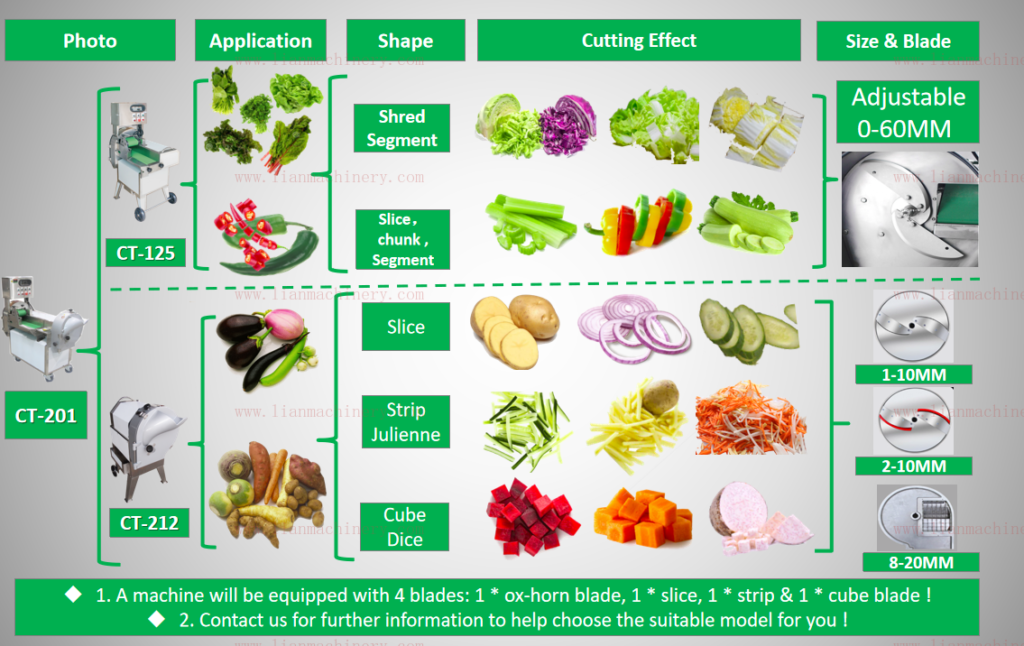Whether you’re running a bustling restaurant kitchen or a large food processing facility, having a reliable vegetable cutting machine can greatly improve efficiency and consistency. However, with a wide variety of machines available, finding the one that best suits your needs can feel overwhelming. Here’s a straightforward guide to help you choose the ideal vegetable cutter for your operation.
1. Identify the Vegetables You’ll Be Cutting
Start by understanding what types of vegetables you’ll be processing. Different machines are tailored to specific vegetable types:
- Leafy Vegetables: Machines designed for leafy greens, like spinach, lettuce, and cabbage, are great for slicing these into thin, even strips.
- Root Vegetables: If you’re working with harder vegetables, like potatoes, carrots, or onions, choose a machine robust enough to cut through denser textures. These machines often allow for options like slicing, dicing, or shredding root vegetables.
- Multi-Function Machines: Multi-functional machines are your best bet if you need versatility. These can handle both leafy greens and root vegetables, offering a range of cuts to suit various dishes.

2. Consider the Type of Cuts You Need
The type of cuts you require will help you decide on the right machine features. For instance:
- Slicing: Ideal for achieving thin, uniform pieces, perfect for salads or garnishes.
- Dicing: Useful for preparing diced vegetables in soups, stews, and salads.
- Shredding: Great for finely shredded vegetables, perfect for coleslaw or stir-fries.
Check that the machine you’re considering has the blade options and settings necessary to achieve these cuts.

3. Think About Processing Volume
The volume of vegetables you need to cut daily plays a big role in selecting a machine. High-output kitchens require a durable, commercial-grade machine that can handle continuous use. These machines are built to withstand heavy demands and deliver consistent results quickly.
For smaller kitchens or low-volume needs, manual or compact electric cutters are often more economical. They’re easy to store, affordable, and suited to smaller batches.
4. Evaluate Power and Speed Settings
If you’re considering an electric vegetable cutter, power and speed settings are key. A more powerful motor will handle tougher produce and higher volumes better, which can be essential in a fast-paced environment.
Some machines also offer adjustable speed settings, which allow you to control cutting speed based on the type of vegetable. This flexibility can be useful if you’re working with a wide variety of produce.
5. Assess Space Requirements
Before purchasing, make sure your kitchen or workspace has adequate room for the machine. Commercial vegetable cutters can be quite large, so ensure it will fit comfortably in your available space and remain easily accessible.
For tight spaces, a compact model might be a more practical choice. Compact machines are easier to store and, though smaller, can still deliver quality results.
6. Look for Easy Maintenance and Cleaning
Keeping your vegetable cutter clean is essential for both hygiene and machine longevity. Opt for models with parts that can be easily removed and cleaned. Stainless steel parts are particularly recommended, as they resist corrosion, are durable, and simplify the cleaning process.
Choosing a machine with smooth surfaces and fewer hard-to-reach areas will also make maintenance easier, ensuring your equipment stays sanitary and functions well over time.
7. Prioritize Safety Features
Safety is paramount when using any kitchen equipment. Here are some features to look for:
- Blade Guards: Prevent accidental contact with sharp blades.
- Emergency Stop Functions: Allow for immediate shut-off in case of an emergency.
- Non-Slip Base: Helps keep the machine stable during use.
- Food-Grade Materials: Choose a machine made from SUS304 stainless steel, which meets food safety standards and is corrosion-resistant. This ensures durability and compliance with hygiene requirements, particularly important in commercial kitchens.
Proper safety training for staff is also essential to minimize the risk of accidents.
8. Set a Realistic Budget
When choosing a vegetable cutting machine, balance your needs with your budget. Manual models are generally more affordable but require more time and effort. Electric and commercial-grade machines cost more upfront but save labor and time, making them more cost-effective for high-volume operations.
Remember to consider the overall cost of ownership, including maintenance and replacement parts, to ensure your choice is a worthwhile investment.
Conclusion
Selecting the right vegetable cutting machine is all about matching the machine’s capabilities to your unique needs, whether they include specific cuts, volume, space limitations, or safety features. By carefully evaluating these factors, you can find a machine that fits seamlessly into your operation and enhances your kitchen’s productivity.
Investing in a well-suited vegetable cutter can streamline your workflow, deliver consistent results, and save valuable prep time. With the right equipment, you’ll be better positioned to serve customers faster and with higher quality.

